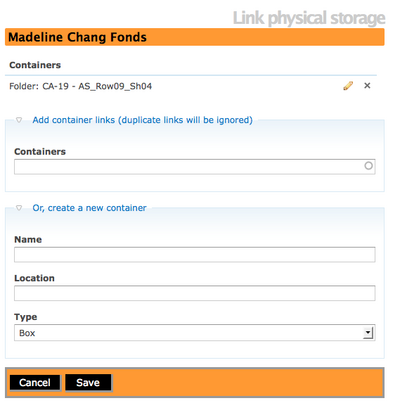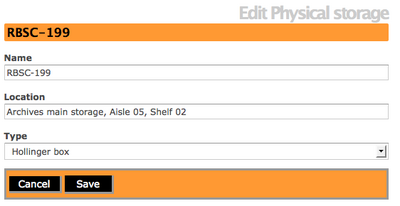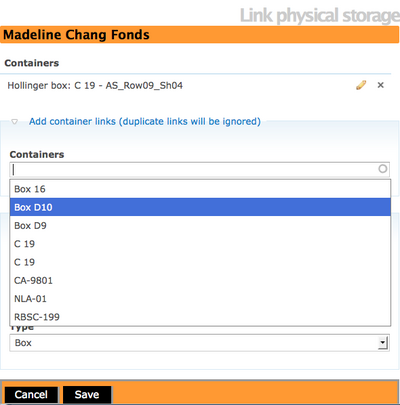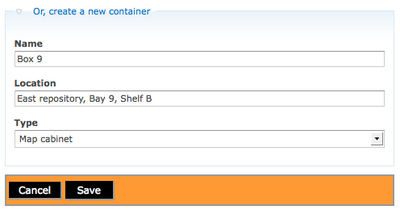Difference between revisions of "Physical storage"
| Line 2: | Line 2: | ||
| − | You can add a physical storage location to an archival description or you can view the [[Glossary#Archival description|archival description's]] current container and location, edit the current container information, delete an existing container, assign to an existing container or assign to a new container. | + | You can add a physical storage container and location to an archival description or you can view the [[Glossary#Archival description|archival description's]] current container and location, edit the current container information, delete an existing container, assign to an existing container or assign to a new container. |
In ICA-AtoM 1.2 release, you can Manage physical storage from the main menu and you can create a physical storage report (e.g., box list) and print it, see [http://ica-atom.org/doc/Create_physical_storage_locations_report_%26_print create physical storage locations report and print page.] | In ICA-AtoM 1.2 release, you can Manage physical storage from the main menu and you can create a physical storage report (e.g., box list) and print it, see [http://ica-atom.org/doc/Create_physical_storage_locations_report_%26_print create physical storage locations report and print page.] | ||
Revision as of 23:13, 20 December 2011
Please note that ICA-AtoM is no longer actively supported by Artefactual Systems.
Visit https://www.accesstomemory.org for information about AtoM, the currently supported version.
Main Page > User manual > Add/edit content > Add/edit archival descriptions > Physical storage
You can add a physical storage container and location to an archival description or you can view the archival description's current container and location, edit the current container information, delete an existing container, assign to an existing container or assign to a new container.
In ICA-AtoM 1.2 release, you can Manage physical storage from the main menu and you can create a physical storage report (e.g., box list) and print it, see create physical storage locations report and print page.
Go to Link physical storage
In the archival description view page click the "Link physical storage" button in the button block.
View current container/location
If the archival description is currently assigned to a container, the "containers" section will appear. This shows the container name, its location, and its type. If the resource is not currently assigned to a container, this section will not appear.
Edit current container
If the archival description is currently assigned to a container and the container information needs to be updated (e.g. the type is not correct or the location has changed), click the "pencil"edit icon. ICA-AtoM routes you to the Edit physical storage screen for the container; change the "Name", "Location", or "Type" as required and click the "save" button in the button block. ICA-AtoM returns you to the archival description view page.
This action updates every archival description registered to the same container; e.g. if six descriptions are registered to box D9, you need only edit box D9 once and the changes will be reflected in all six descriptions.
Assign to an existing container
To assign the resource to a different container or additional container, use the drop-down menu to select the container you want to use. When you save the record, ICA-AtoM will update the description.
Assign to a new container
If the container you want to use does not appear in the drop-down menu, it is not registered in the system and needs to be created; use the "create a new container" section for this. Enter the container name, type, and location. When you save the record, ICA-AtoM creates the container and assigns the resource to it.
Delete a container
Navigate to the container from the context menu of an archival description by selecting the "Link physical storage" button in the button block and under the Containers area, click the "X" delete icon. This will delete the container from all linked archival descriptions but will not delete the descriptions themselves.



